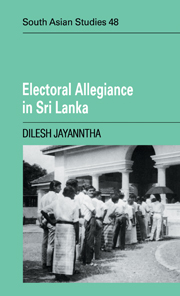Book contents
- Frontmatter
- Contents
- Acknowledgments
- List of abbreviations
- 1 Introduction
- 2 Bluville: the constituency and the patronage network of Doctor Ay (1947–1959)
- 3 Bluville: the patronage network of Korale-Mudaliyar Kit Foo and his son, Dee (1947–1959)
- 4 Bluville: the growth of the State (1956–1982)
- 5 Greenville: the patronage networks of the Mou/Nous and the Pou/Kous (1947–1959)
- 6 Greenville: the growth of the State (1956–1982)
- 7 Red Town: the urban setting (1947–1959)
- 8 Red Town: the growth of the State (1956–1982)
- 9 Communal minorities, political dissidents and the JVP
- 10 Conclusion
- Glossary of Sinhalese Terms
- References
- Index
- CAMBRIDGE SOUTH ASIAN STUDIES
8 - Red Town: the growth of the State (1956–1982)
Published online by Cambridge University Press: 11 September 2009
- Frontmatter
- Contents
- Acknowledgments
- List of abbreviations
- 1 Introduction
- 2 Bluville: the constituency and the patronage network of Doctor Ay (1947–1959)
- 3 Bluville: the patronage network of Korale-Mudaliyar Kit Foo and his son, Dee (1947–1959)
- 4 Bluville: the growth of the State (1956–1982)
- 5 Greenville: the patronage networks of the Mou/Nous and the Pou/Kous (1947–1959)
- 6 Greenville: the growth of the State (1956–1982)
- 7 Red Town: the urban setting (1947–1959)
- 8 Red Town: the growth of the State (1956–1982)
- 9 Communal minorities, political dissidents and the JVP
- 10 Conclusion
- Glossary of Sinhalese Terms
- References
- Index
- CAMBRIDGE SOUTH ASIAN STUDIES
Summary
The 1956 Election: antecedent factors
Temples are popularly believed to have played a major role in the 1956 Election. However, the actual effectiveness of priests in swaying the electorate is likely to have been small, or non-existent. This was because, first, for the reasons elaborated in Chapter 7, they wielded little, if any, ‘moral influence’ amongst the public. Secondly, there were more important socio-economic factors which explained the anti-UNP swing of 1956; in particular, their alienation of certain economically under-privileged groups. The anti-Western cultural tone the SLFP campaign of 1956 assumed merely provided the veneer for the articulation of their interests.
Nationally, the UNP regime of 1947–56 had done little to develop local industry. The implications of this were not felt so long as the Korean War boom lasted. Commodity exports fetched high prices, and the balance of payments and rupee remained strong. A high level of consumption could be maintained, with expensive welfare programmes, in particular, free education, health and consumer subsidies. All this changed with the collapse of the boom. World trade contracted, the payments situation worsened, and the rupee depreciated. The Government was forced to curtail its consumption and many of its welfare programmes. Most significant was its decision to reduce the rice subsidy, forcing the price up from 25 cents a measure to 70 cents a measure. The move generated widespread ill-will, particularly in the urban areas. The Hartal of 12 August 1953, organized by the leftist parties to protest against the measure, led to a general closure of business establishments and Government offices, and the sabotage of public works.
- Type
- Chapter
- Information
- Electoral Allegiance in Sri Lanka , pp. 157 - 182Publisher: Cambridge University PressPrint publication year: 1992



